Return
To Page Two
Chewing
Insects
Page
Three
Hibiscus Beetle
Hibiscus
..Beetle
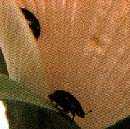
Size: X 4.0
Commonly called Hibiscus Beetle scientific name is Macoura concolor
(Macleay)
This Beetle is satin black, oval in shape & tapered at each end
to facilitate easy entry between the closed folds of petals of the Hibiscus
flower buds.
It is about 3 mm long & belongs to the family Nitidulidae.
Often found in large numbers within the Hibiscus flowers.
It is predominately a pollen & nectar feeder, although they are
known to damage the petals.
Damage to foliage has not been recorded.
The Hibiscus Beetle will consume the pollen of the unopened flower
bud the females lay eggs near the nectary & the damaged bud drops from
the bush prior to Opening.
The bud decays quickly & the larva hatch out consuming the bud
remains.
A short pupal stage is undergone beneath the soil, where upon the adult
beetle emerges to complete the cycle.
Hibiscus populations closely coincide with warm temperatures &
flowers production.
The lighter colours of white, pink, & yellow, seem to attract more
hibiscus than the less brighter colours of red, dark orange & browns.
Hibiscus Beetle On
Yellow Hibiscus Flower
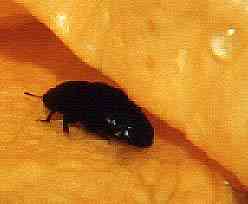 Size: X 30.0
Hibiscus Beetle Consuming Pollen of Hibiscus
Size: X 30.0
Hibiscus Beetle Consuming Pollen of Hibiscus
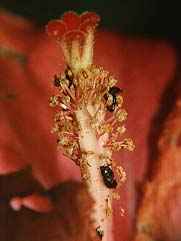


.Size:
X 3.0.................Size:
X 5.0...................Size:
X 15.0
Hibiscus Beetle
Entering Flower Bud
 Size: X 3.0
Hibiscus Flower Buds
Damaged by Hibiscus Beetle
Size: X 3.0
Hibiscus Flower Buds
Damaged by Hibiscus Beetle
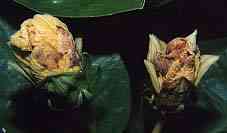 Size: X 2.0
Size: X 2.0
Weevil
.......Weevil

...Size: X 10.0
Common name for most members of the beetle super family Curculionoidea.
The adult weevil is usually dull in color and is herbivorous. It is characterized
by a prolongation of the anterior part of the head into a rostrum (a beak
like extension). The apex of the rostrum contains the biting mouth parts,
and two clubbed antennae are attached in depressions at each side. The
oval body is covered with a rough, hard integument, and a single median
suture traverses the lower part of the head. Weevils exhibit complete metamorphosis.
The larvae are white, semicircular, fleshy grubs with vestigial legs,
strong jaws, and rudimentary eyes; they feed entirely on plant life, causing
much damage to crops. The adults usually hibernate for most of the winter.
Weevil Larvae
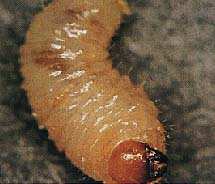
 Size: X 40.0
Names that have been applied to families or subfamilies of weevils include
fungus weevils (Anthribidae), straight-snouted or primitive weevils (Brentidae),
snout beetles or snout weevils (Curculionidae), leaf-rolling weevils (Eremninae,
Leptopiinae, Tanymecinae, Thylacitinae, Brachyrhininae), grain weevils
(Rhyncho-phorinae), pine weevils (Pissodinae), clover weevils (Hyperinae),
ant like weevils (Myrmecinae), flea weevils (Rhyncharninae), acorn and
nut weevils (Curculioninae), and short-snouted weevils (Otiorhynchinae).
Size: X 40.0
Names that have been applied to families or subfamilies of weevils include
fungus weevils (Anthribidae), straight-snouted or primitive weevils (Brentidae),
snout beetles or snout weevils (Curculionidae), leaf-rolling weevils (Eremninae,
Leptopiinae, Tanymecinae, Thylacitinae, Brachyrhininae), grain weevils
(Rhyncho-phorinae), pine weevils (Pissodinae), clover weevils (Hyperinae),
ant like weevils (Myrmecinae), flea weevils (Rhyncharninae), acorn and
nut weevils (Curculioninae), and short-snouted weevils (Otiorhynchinae).
The largest family, Curculionidae, comprises several subfamilies and
contains 30,000 to 40,000 species. Most are grouped under the subfamily
Curculioninae, of which Curculio is the characteristic genus. This genus,
which contains the nut and acorn weevils, has species characterized by
a bulky body and a long, slender beak. In the female, the beak is usually
longer than the entire body; it is used for drilling holes in nuts or acorns
and for placing the eggs in the kernels. (Squirrels often open acorns in
search of the larvae.) When the nuts fall to the ground, the larvae burrow
underground and pupate the following July. The adults average 0.7 cm (0.3
in) from the front margin of the head to the tip of the abdomen. Some weevils
of the family Curculionidae spend much of the adult and larval stages within
various fruits. See also Boll Weevil .
The tiny granary weevil, Sitophilus granarius, of the subfamily Rhynchophorinae,
is chestnut brown or black. The females produce numerous eggs six times
a year and deposit them inside the grain kernels. The similar rice weevil,
S. oryzae, is native to India and infests rice and other grains throughout
the world. It is a common pantry pest, found frequently in crackers, packaged
cereals, or other dried foods. The alfalfa weevil, Hypera postica, native
to Europe, causes extensive damage to the leaves of the alfalfa crop. Brought
to Utah in the early 1900s, it spread later into all the Rocky Mountain
states and, more recently, into California and Washington.
Another group of beetles commonly known as weevils, but more closely
related to the leaf beetles of the family Chrysomelidae, are the bean or
pea weevils of the family Bruchidae. The pea weevil, Bruchus pisorum, lays
numerous eggs once a year on the pods of young peas, the larvae boring
into the seed to pupate. The bean weevil, Acanthoscelides obtectus, lays
eggs on or within the bean pod.
Control.
Different Species Of Adult Weevils

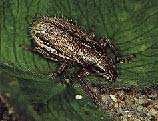
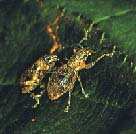 Sizes: X 15.0
.
Damage To Hibiscus
Leaves By Adult Weevil
Sizes: X 15.0
.
Damage To Hibiscus
Leaves By Adult Weevil
 Size: X 0.50
Size: X 0.50
.Return
To Page Two















